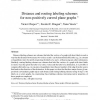JAL
2006
14 years 12 days ago
2006
Distance labeling schemes are schemes that label the vertices of a graph with short labels in such a way that the distance between any two vertices u and v can be determined effic...
COMBINATORICS
2007
14 years 13 days ago
2007
This work introduces the technique of using a carefully chosen determining set to prove the existence of a distinguishing labeling using few labels. A graph G is said to be d-dist...
EJC
2010
14 years 15 days ago
2010
We consider plane trees whose vertices are given labels from the set {1, 2, . . . , k} in such a way that the sum of the labels along any edge is at most k + 1; it turns out that ...
DAM
2008
14 years 15 days ago
2008
We consider the vertex coloring problem, which may be stated as the problem of minimizing the number of labels that can be assigned to the vertices of a graph G such that each ver...
DM
2010
14 years 15 days ago
2010
We introduce the concept of an edge-colouring total k-labelling. This is a labelling of the vertices and the edges of a graph G with labels 1, 2, . . . , k such that the weights o...
COGSCI
2010
14 years 16 days ago
2010
Symbols enable people to organize and communicate about the world. However, the ways in which symbolic knowledge is learned and then represented in the mind are poorly understood....
DGO
2006
14 years 1 months ago
2006
Government agencies must often quickly organize and analyze large amounts of textual information, for example comments received as part of notice and comment rulemaking. Hierarchi...
SIROCCO
2007
14 years 1 months ago
2007
Recently, quite a few papers studied methods for representing network properties by assigning informative labels to the vertices of a network. Consulting the labels given to any t...
VMV
2008
14 years 1 months ago
2008
This work presents a real-time, data-parallel approach for global label assignment on regular grids. The labels are selected according to a Markov random field energy with a Potts...
AAAI
2010
14 years 1 months ago
2010
Modeling human behavior requires vast quantities of accurately labeled training data, but for ubiquitous people-aware applications such data is rarely attainable. Even researchers...




